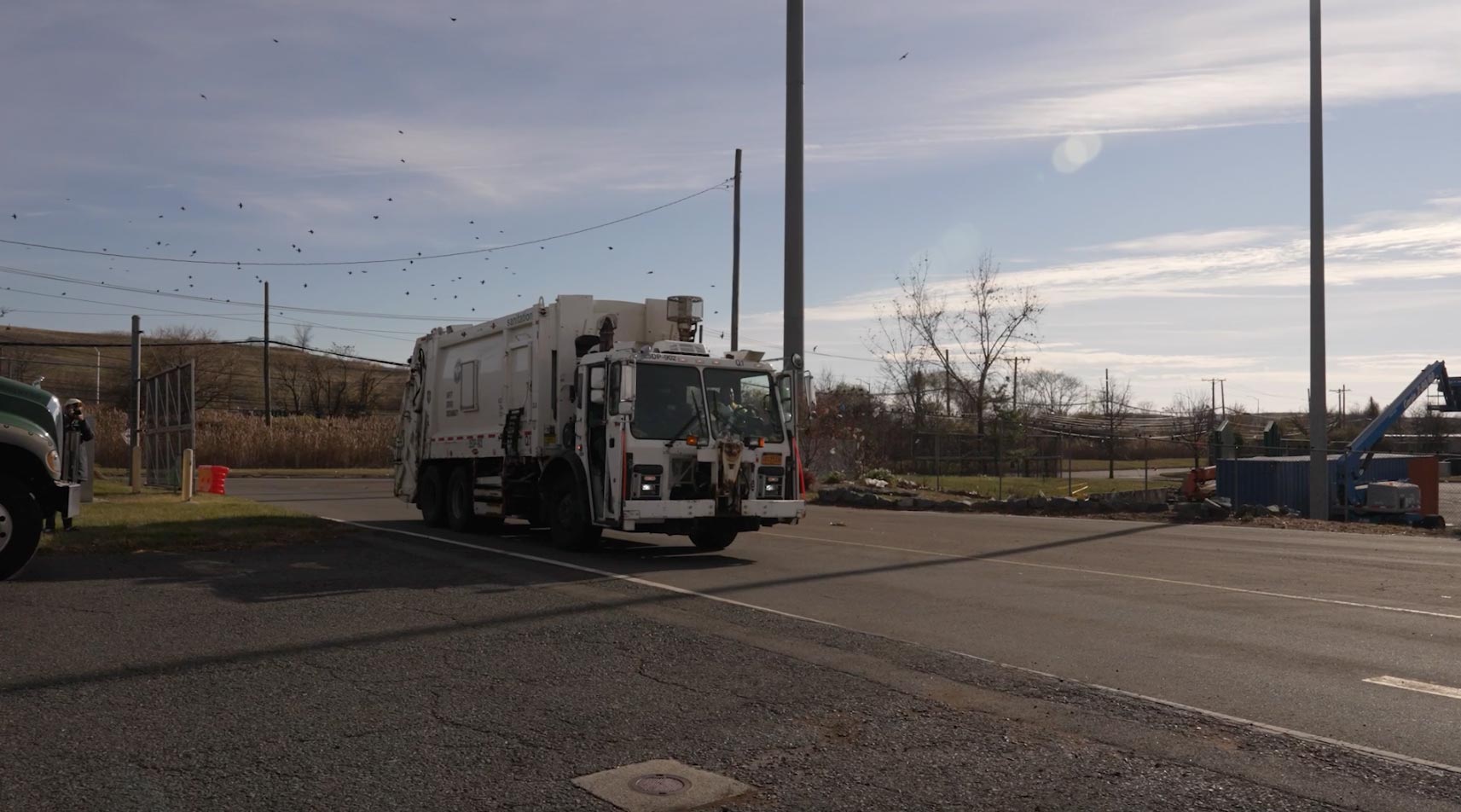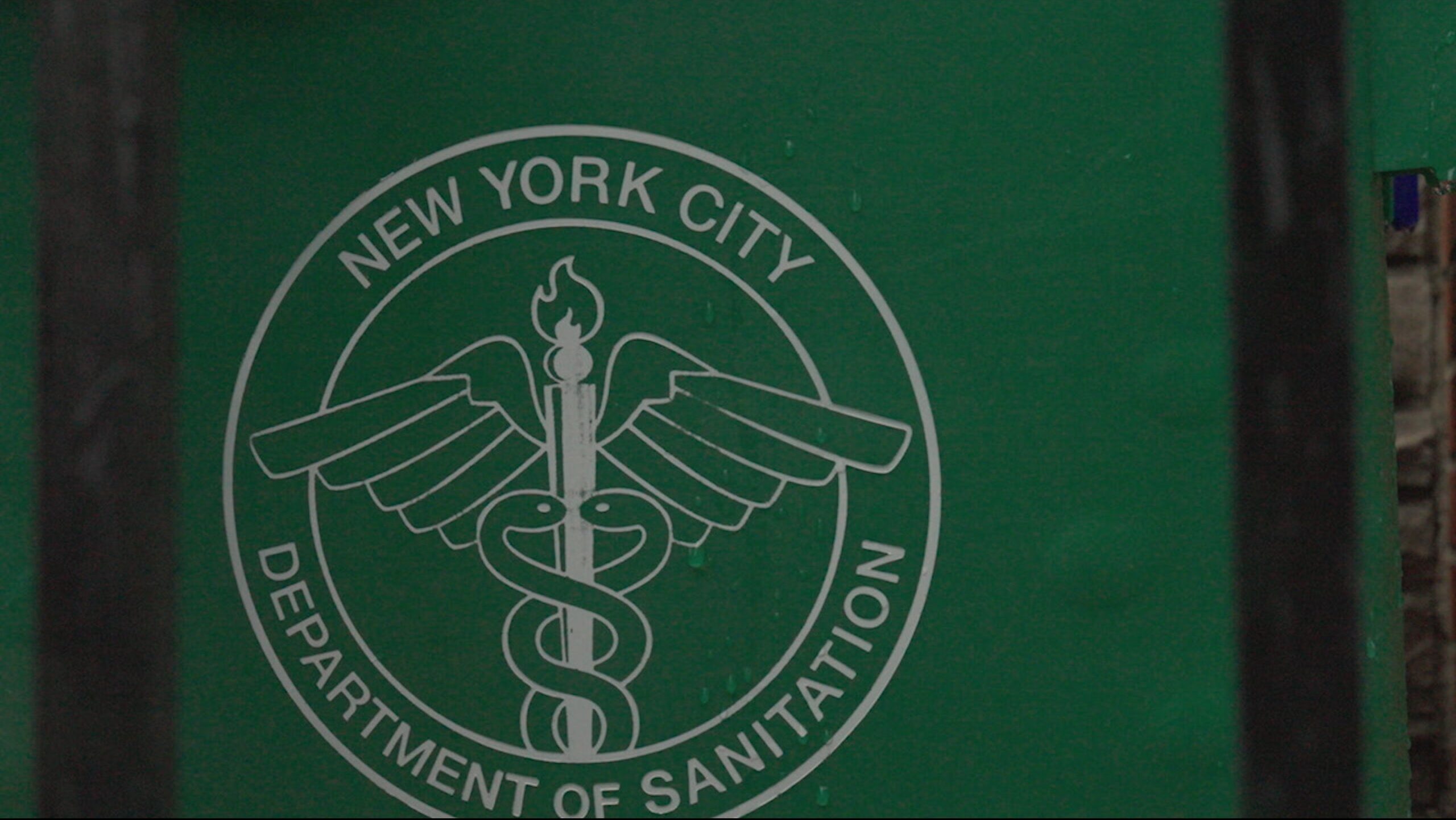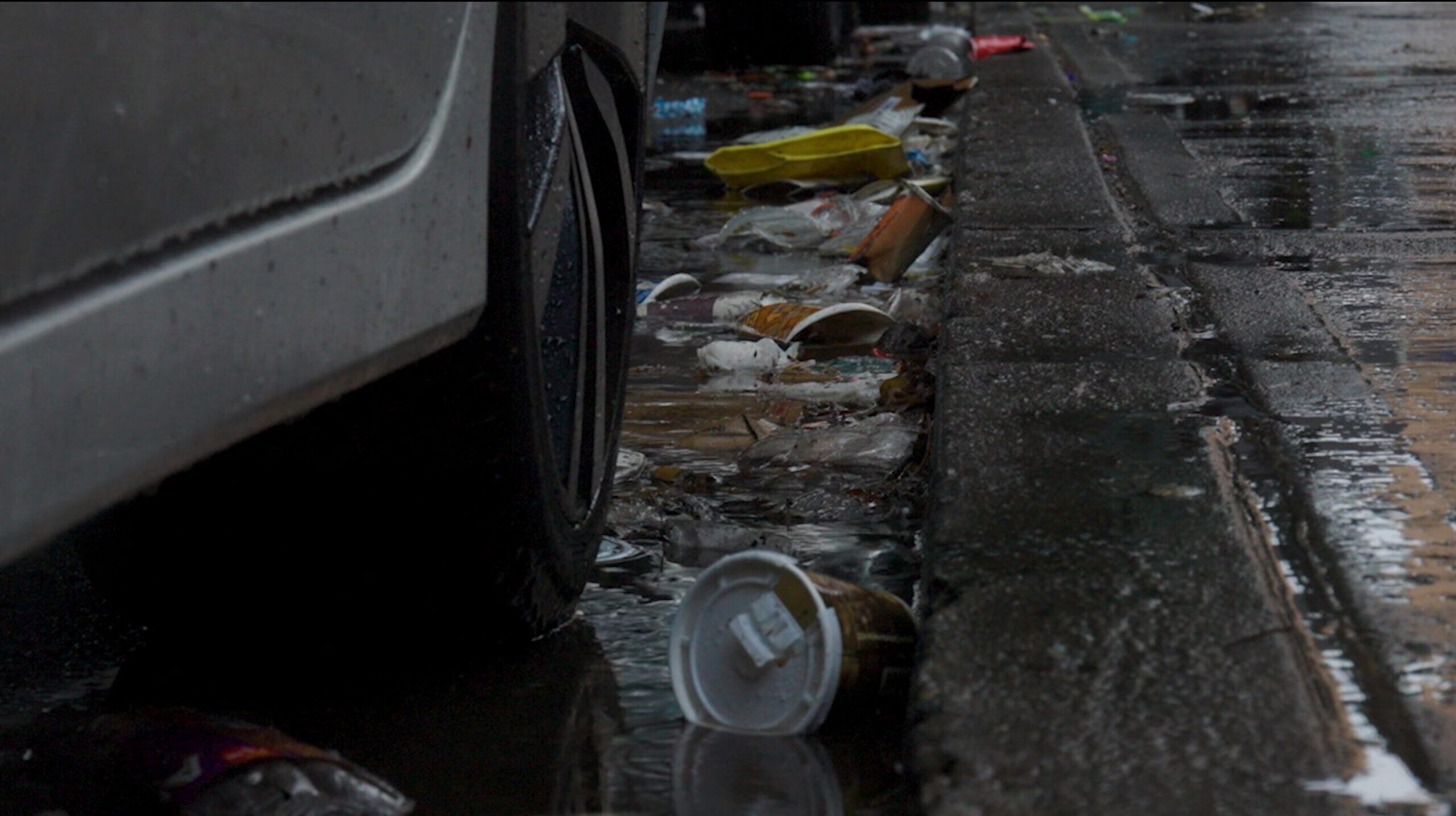
Mandatory Composting Arrives to the Big Apple
By Elliot Zepeda
Tucked away between several Corona homes, the “Comadres Bordadoras” (or “Embroidery Comadres” in English) knit and gossip in the privacy of cherry tomato bushes and bell pepper leaves, nestled within their narrow community garden on 97th Street in Queens. For over a year, they have gathered every Monday morning at this street block association, where they unload not just the week’s chatter, but their compost too.
Although the municipal curbside composting program was first launched in Queens back in October 2022, Flaviana Linares, a founding member of the Embroidery Comadres, says she hasn’t seen a single composting bin on her street, just a few blocks from their community garden. “My landlord has just one large bin and wants us to put everything in it, no separating the waste,” she says.

Embroidery Comadres holding their weekly meeting at the 97th St Community Garden. Photo by E. Zepeda
As a result, the members of this community garden have been disposing some of their organic waste directly into the garden’s soil beds, bringing small plastic bags of food scraps whenever possible to help nurture their plants.
However, with the new citywide curbside composting mandate across all five boroughs —which requires New Yorkers to separate organic waste from trash and place it in composting bins provided for weekly pickup on recycling day— these Queens residents worry they may not be able to comply with the regulations on such a large scale. “Many of us share apartments with other families, and there’s no space to store a week’s worth of food scraps,” Gabriela Paiero says.
“Blessed and privileged are those of us who don’t have to share an apartment. But for those of us who do, it’s just not possible. My family is made up of five people, that thing would be full in a day,” Linares says.

DSNY compost bin in West Harlem. Photo by E. Zepeda
Across the East River in Manhattan, 58th Street resident Neville Lala notes that kitchen garbage bins, designed to keep organic waste away from rats and odors before being placed in curbside bins, come at an additional cost. “Living in the city is hard enough, it costs just to breathe, and now we need to buy another garbage can,” he says. A well-sealed bin is particularly important in the summer, when accumulated organic waste, according to Elisabeth Tolaba —who has tried separating her food scraps during these hotter months— can become “pretty smelly,” especially in smaller apartments.
Adding to the costs, Queens residents who didn’t order brown bins from DSNY during their designated periods in 2022 can no longer get one for free. The same applies to Brooklynites, who joined the program a year later. Manhattan, Bronx, and Staten Island residents were eligible to request a free curbside compost bin from the Department of Sanitation until October 24. Now, New Yorkers across all five boroughs must either purchase the official DSNY brown bin for $43.47 or use a generic bin with a secure lid to keep rats away and request a free official decal from DSNY to label it.
This mandate came as a great surprise to Lala, who, despite having a separate bin management system on every floor of his 14-story Manhattan building, notes that his building has yet to provide bins for organics or inform tenants about the new requirement.
Vincent Gragnani, a press secretary for the Department of Sanitation, says residential buildings with nine or fewer units —whose residents typically manage their own trash— received door-to-door notifications about the new mandate in the months surrounding the launch of the program. Moreover, he highlights the interviews conducted by former DSNY Commissioner Jessica Tisch with major networks to inform residents about the mandate.
Additionally, DSNY still offers virtual information sessions in English, Spanish, and Chinese to help residents learn more about the curbside composting program.

Screen capture of DSNY virtual information session.
“It’s a hot mess!” Erickson Gil, building cleaner and maintenance professional who manages properties in West Harlem, says about the new organic collection mandate.
“You give residents instructions, you tell ‘em, but they just don’t do it. They throw whatever in there,” says Gil, who compares his incessant reminders to residents as “babysitting.” “You gotta have people that are willing to be very disciplined in the community to make that work.”

Erickson Gil taking out the trash in a West Harlem building. Photo by E. Zepeda
New Yorkers across the five boroughs have until April 2025 before they start getting fined for mixing their organics with other trash —just as they are now for not separating recyclables. Buildings with nine or more units will be fined $100 for the first offense, with an additional $100 for each subsequent violation. For buildings with one to eight units, the fine is reduced to $25 for the first offense, with the same amount added for each following infraction. The fine will be imposed on the property owner.
For full compliance, organics —such as food scraps, food-soiled paper, meat, bones, dairy, prepared foods, greasy uncoated paper plates, pizza boxes, and products labeled as compostable— can be placed inside a paper, compostable, or clear plastic bag. The bag must then be placed inside a compost bin, which can also be lined with a bag of the same characteristics. Yard waste does not need to be in a bin and can be left at the curb in a paper, compostable, or clear plastic bag.
Historically, most of New York City’s food waste ended up in landfills, where it released methane —a potent greenhouse gas that contributes to global warming. Today, that waste is either composted into soil fertilizer or processed into biogas, helping to reduce methane emissions. These efforts are led primarily by the Staten Island Compost Facility and the Newtown Creek Treatment Facility in Brooklyn.

Newtown Creek Treatment Facility in Greenpoint, Brooklyn, operated by the Department of Environmental Protection (DEP). Photo by E. Zepeda
New York City is not the first to implement widespread composting mandates for residents. San Francisco led the way in 2009 and expanded the program statewide in California by 2022. A few years earlier, in 2020, Vermont did the same. Abroad, South Korea has been a leader, banning the landfilling of food waste across the country in 2005 and picking up organic waste daily. Most recently, France introduced a similar nationwide composting mandate, which took effect on January 1, 2024.
Drawing on these international examples, Erickson Gil proposes a pick-up schedule similar to the South Korean model, arguing that one day a week isn’t enough to keep up with the amount of organic waste produced by New Yorkers. “Let’s say you have a 17-18 family building and you’re only allowed to bring those out one day out of the week on recycling day. Those things get full in literally two days, ‘cause they small. If they could go out every time the black [bins] go out, which is every other day, it’ll be better.”
Until that happens, New Yorkers can also use the orange “Smart Composting Bins” scattered across the city to drop-off their organic waste. These bins can only be unlocked using the NYC Compost App and are available 24/7. Introduced in 2021 and expanded over the years, they could help alleviate the strain on fast-filling curbside brown bins, particularly in neighborhoods like Jackson Heights and Corona, where multiple families often share a single unit.
However, a closer look at the drop-off site map reveals a significant shortage of these bins in Queens, with a higher concentration in Manhattan and parts of Brooklyn. When questioned about the reasoning behind their placement, Gragnani, the DSNY press secretary,. explained that, “among many factors,” they focused on creating “a route that can be efficiently serviced six days a week.”

Locations of “Smart Composting Bins” drop-off sites in NYC (in orange). Image from DSNY’s website.
“I wish those orange bins were on the main streets of our communities, like in Corona Plaza, and, more importantly, that our communities were better informed about the importance of composting,” Linares says, as she picks weeds from the community garden in Queens.
Paiero agrees.
“The city isn’t putting enough effort to make this known to our neighbors. They tell you to compost, but they don’t explain how. I would like to see more announcements on the radio, television, and at community centers.”
With two months having passed since the citywide mandate was introduced, and more outreach campaigns still to come, it’s too early to assess its impact, such as whether trash weight has decreased or rat populations have dropped. However, Jennifer McDonnell, Assistant Commissioner of Solid Waste Management at the Department of Sanitation, is certain of one thing: “It’s hard to convince New Yorkers to do anything.”
Trash in the Big Apple – Where is it Going?
By Carrie Johnson
The Trash: Where Our Disposed Items Find Community
Imagine—you’re running late for work or class, again, and one hand is struggling to push through the small hole you’ve opened in your bag so your fingers can grab your ID for the scanner at the door because you know that security guard won’t let you inside unless he sees the bright green approval of the scanner, even though he’s seen your face every day, but you can’t seem to grab your ID because your other hand has your oversized coat for this too hot of a winter day thrown over your arm and your fingers are gripping an empty coffee cup that you’re desperately trying to throw away but where the hell are the trash cans in this city?
You spot a trash can, finally, on the corner coming up, inconspicuously blending in with the rest of city life, stickers and graffiti covering the gray metal. You hurriedly walk by and drop your empty coffee cup into the bin, most likely never to think of it again as you hustle through the doors to disingenuously tell the security guard good morning. Meanwhile, the coffee cup is forgotten, other trash piling on top as the day progresses.
New York City generates more than 14 million tons of waste and recyclables, with trash and recycled materials streaming in from the five boroughs: Manhattan, Brooklyn, Queens, Staten Island and the Bronx. Where the trash goes and what becomes of our thrown-away coffee cups, leftovers and other tossed items is a story that many in New York City think they know how to tell.

A motorcycle zooms by trash piled against a beam as the train overhead rubbles on. Photo by Carrie Johnson
The Department of Sanitation is the largest department in the country and has been around since 1881, “always refining and improving” and growing with the changes of the city, according to Joshua Goodman, Deputy Commissioner of Public Affairs & Customer Experience. Their process of expediting trash is rigorous, set in full motion after the closing of the Freshkills Landfill (now turned into the Freshkills Park) in Staten Island in 2001.
The first step in the journey of trash begins with the resident. Goodman says it’s the responsibility of the citizen to separate trash from recyclables in their home before the trash then sits on the curb for pickup.
Then, depending on which part of the city since every part has a collection schedule, trucks going out on one of three shifts will pick up the bags. These shifts run from 6 a.m. to 2 p.m., 4 p.m. to midnight and midnight to 8 a.m.
The trucks then transport the trash to their designated facility, otherwise known as a transfer station. Transfer stations are the midway points between the city and the landfills.
Trucks dump the trash into a big chamber and into an area called “the tipping floor,” where sanitation workers use heavy machinery to load the trash into containers to set sail via waterway for two possible destinations. The State of New York harbors hundreds of transfer facilities, with New York City holding 58 waste transfer stations.
“This is a system that affects every single New Yorker, every single day,” Goodman said. “I would want them [New Yorkers] to know that our job is to make the trash disappear but it is a big job. You wake up and the bags are already gone, that’s because we’ve been up for hours.”

The symbol for the New York City Department of Sanitation on a green container in a resident’s yard. Photo by Carrie Johnson
Where Else? Right Back to You
The first possible destination is a waste-to-energy facility, like Waste Management (WM) and Reworld Waste (formerly known as Covanta), partners of the Department of Sanitation.
“DSNY’s marine transfer system is truly unique. It is the most advanced waste transfer system of its kind in North America and we’re proud of our role to provide reliable, sustainable services to the city,” said Nicolle K. Robles, the director of Communications at Reworld Waste.
Once the trash from transfer stations is taken to the waste-to-energy facilities, it is then sorted through again before entering the combustion station. Here, the heat turns water into steam, which is turned into energy. All of this creates more steam which is condensed back to water for the boiling tubes. Metal is then collected for the making of new products and the ash is sent to landfills as non-hazardous waste. Human health and the environment are at the forefront of the entire process, Robles said.

A worker is seen outside one of the Transfer Facilities in Brooklyn, New York. Photo by Carrie Johnson
Robles said Reworld, DSNY and other partners have been able to annually manage 20 million tons of waste sustainability, recover 500,000 tons of metals, reuse 280 million gallons of wastewater and generate 10 million MWHe of energy from waste. She said these efforts have helped to avoid 41 million metric tons of greenhouse gases annually which is the equivalent to the amount of CO2 sequestered by 40 million acres of forest, or eight states of the United States.
“The real work and progress is being made by adapting a broader approach to waste, deploying a variety of existing and evolving technologies, instead of waiting for a magical fix,” Robles said. “We are only stronger when we work together, especially with such a monumental challenge like waste.”
Trash that can’t be turned into electricity is destined for the landfills, found in Virginia and South Carolina.
The Journey of Trash: A Look at the End(?)
While the forgotten coffee cup may either turn into the surge of electricity you use when you’re hurriedly brushing your teeth in the morning with your electrical toothbrush, or become part of a landscape of trash in a landfill, these actually aren’t the only possible outcomes—it may turn into something else entirely if Materials for the Arts has something to do with it.
Materials for the Arts (MFTA) is an organization that is a part of the Department of Cultural Affairs, which is a partner of the DSNY. MFTA works to ensure that materials still having value are kept from entering landfills. These saved materials are reused by art professionals, educators and students.
With their focus and intention being on reuse, more comes through the doors of MFTA than just art supplies. Anything that’s not considered dangerous, like broken glass, is usable. From giant rolls to a single piece of fabric or an individual piece of paper, MFTA finds a way.
Buttons, ribbon, thread, candlesticks, chairs, wood, office supplies, and even electronics are available to offer opportunities for users to use anything and everything.

On the side of the road on a rainy day, trash lines the curb. Photo by Carrie Johnson
John Cloud Kaiser, the director of Education at Materials for the Arts, got his start with the organization after his background as an artist of all trades, but more specifically, with interactive sculptures in his community. He used materials straight from Materials for the Arts for assistance with his projects.
“We want people to feel empowered to identify as artists. And we think that perhaps one of the roadblocks to that would be that traditionally, art is defined by using certain types of materials,” Kaiser said. “And so if we’re able to kind of open it up and say anything can be art and you don’t have to go buy it, just use the leftover stuff, then all of a sudden it just immediately empowers everybody, to be honest.”
MFTA keeps a foot in both the sustainability and art worlds, gaining traction in terms of recycling and sustainability that MFTA appears on DSNY’s report at the end of the year that says how much waste was sent where by the sanitation department.
“Sometimes sanitation might not have the ability to do certain things, but they can do what’s called a pass through, which is like they can fund some other organizations to do it on their behalf,” Kaiser said.
The cycle of trash is one that many in New York critique, ridicule, judge, respect, fight against and support. Whether your coffee cups end up as energy, piling up a landfill or the next art and craft of an elementary student, the next time you drop it in a bin, you’ll have an idea of where the hell it goes in a city like New York.